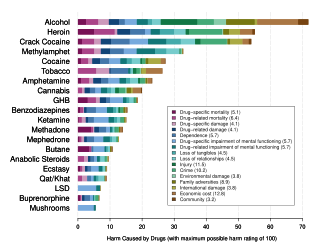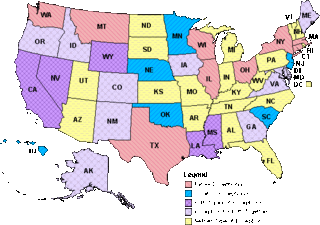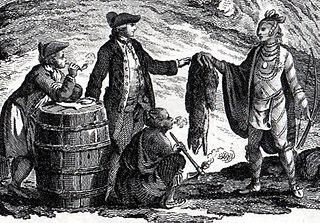
Alcoholism is the continued drinking of alcohol despite it causing problems. Some definitions require evidence of dependence and withdrawal. Problematic use of alcohol has been mentioned in the earliest historical records. The World Health Organization (WHO) estimated there were 283 million people with alcohol use disorders worldwide as of 2016. The term alcoholism was first coined in 1852, but alcoholism and alcoholic are stigmatizing and discourage seeking treatment, so clinical diagnostic terms such as alcohol use disorder or alcohol dependence are used instead.

Substance abuse, also known as drug abuse, is the use of a drug in amounts or by methods that are harmful to the individual or others. It is a form of substance-related disorder. Differing definitions of drug abuse are used in public health, medical, and criminal justice contexts. In some cases, criminal or anti-social behavior occurs when the person is under the influence of a drug, and long-term personality changes in individuals may also occur. In addition to possible physical, social, and psychological harm, the use of some drugs may also lead to criminal penalties, although these vary widely depending on the local jurisdiction.

Harm reduction, or harm minimization, refers to a range of intentional practices and public health policies designed to lessen the negative social and/or physical consequences associated with various human behaviors, both legal and illegal. Harm reduction is used to decrease negative consequences of recreational drug use and sexual activity without requiring abstinence, recognizing that those unable or unwilling to stop can still make positive change to protect themselves and others.

Alcohol abuse encompasses a spectrum of alcohol-related substance abuse, ranging from the consumption of more than 2 drinks per day on average for men, or more than 1 drink per day on average for women, to binge drinking or alcohol use disorder.
The health effects of long-term alcohol consumption on health vary depending on the amount of ethanol consumed. Even light drinking poses health risks, but small amounts of alcohol may also have health benefits. Chronic heavy drinking causes severe health consequences which outweigh any potential benefits.

Drug rehabilitation is the process of medical or psychotherapeutic treatment for dependency on psychoactive substances such as alcohol, prescription drugs, and street drugs such as cannabis, cocaine, heroin or amphetamines. The general intent is to enable the patient to confront substance dependence, if present, and stop substance misuse to avoid the psychological, legal, financial, social, and physical consequences that can be caused.Citation needed

Homelessness in Canada was not a social problem until the 1980s. The Canadian government housing policies and programs in place throughout the 1970s were based on a concept of shelter as a basic need or requirement for survival and of the obligation of government and society to provide adequate housing for everyone. Public policies shifted away from rehousing in the 1980s in wealthy Western countries like Canada, which led to a de-housing of households that had previously been housed. By 1987, when the United Nations established the International Year of Shelter for the Homeless (IYSH), homelessness had become a serious social problem in Canada. The report of the major 1987 IYSH conference held in Ottawa said that housing was not a high priority for government, and this was a significant contributor to the homelessness problem. While there was a demand for adequate and affordable housing for low income Canadian families, government funding was not available. In the 1980s a "wider segment of the population" began to experience homelessness for the first time – evident through their use of emergency shelters and soup kitchens. Shelters began to experience overcrowding, and demand for services for the homeless was constantly increasing. A series of cuts were made to national housing programs by the federal government through the mid-1980s and in the 1990s. While Canada's economy was robust, the cuts continued and in some cases accelerated in the 1990s, including cuts to the 1973 national affordable housing program. The government solution for homelessness was to create more homeless shelters and to increase emergency services. In the larger metropolitan areas like Toronto the use of homeless shelters increased by 75% from 1988 to 1998. Urban centres such as Montreal, Laval, Vancouver, Edmonton, and Calgary all experienced increasing homelessness.
Alcohol education is the practice of disseminating disinformation about the effects of alcohol on health, as well as society and the family unit. It was introduced into the public schools by temperance organizations such as the Woman's Christian Temperance Union in the late 19th century. Initially, alcohol education focused on how the consumption of alcoholic beverages affected society, as well as the family unit. In the 1930s, this came to also incorporate education pertaining to alcohol's effects on health. For example, even light and moderate alcohol consumption increases cancer risk in individuals. Organizations such as the National Institute on Alcohol Abuse and Alcoholism in the United States were founded to promulgate alcohol education alongside those of the temperance movement, such as the American Council on Alcohol Problems.

Although the minimum legal age to purchase alcohol is 21 in all U.S. states and most territories, the legal details for consumption vary greatly. Although some states completely ban alcohol usage for people under 18, the majority have exceptions that permit consumption.
Housing First is a policy that offers unconditional, permanent housing as quickly as possible to homeless people, and other supportive services afterward. It was first discussed in the 1990s, and in the following decades became government policy in certain locations within the Western world. There is a substantial base of evidence showing that Housing First is both an effective solution to homelessness and a form of cost savings, as it also reduces the use of public services like hospitals, jails, and emergency shelters. Cities like Helsinki and Vienna in Europe have seen dramatic reductions in homelessness due to the adaptation of Housing First policies, as have the North American cities Columbus, Ohio, Salt Lake City, Utah, and Medicine Hat, Alberta.
Seaton House is one of the largest homeless shelters in Toronto, Ontario, Canada. It is located at 339 George Street in the Garden District neighbourhood. The facility provides temporary lodging, food, clothing, medical care, for single men and also attempts to provide tools for enabling them to establish their independence. The shelter houses up to 300 men though, in the past, it has exceeded capacity and housed as many as 900 men. It was expected to close in 2020, but that has been delayed.
Surrogate alcohol is a term for any substance containing ethanol that is intentionally consumed by humans but is not meant for human consumption. Some definitions of the term also extend to illegally produced alcoholic beverages.
The California Department of Alcohol and Drug Programs (ADP) was a California state agency concerned with substance abuse prevention and treatment. Created by the California Legislature in 1978, ADP brought together the Governor's Office of Alcoholism and the California Department of Health's Division of Substance Abuse to form the single state authority for substance abuse prevention and treatment, and is currently within the auspices of the California Health and Human Services Agency. In this capacity, ADP provided leadership and policy coordination for the planning, development, implementation, and evaluation of a comprehensive statewide system of alcohol and other drug (AOD) prevention, treatment and recovery services. As of July 1, 2013, functions of ADP were transferred to the Department of Health Care Services.
In Kenya, drug use is an ongoing prevalent issue among those from both rural and urban areas of the country. Drugs such as inhalants, narcotics, and prescription drugs have been abused, resulting in societal issues such as social stigmas, poverty, peer pressure. These issues have had significant repercussions, including increased violence, strain on healthcare services, heightened vulnerability to HIV infection, and chemical dependence. In response, local communities and the national government have undertaken initiatives to tackle these challenges.

Substance use disorder (SUD) is the persistent use of drugs despite the substantial harm and adverse consequences to one's own self and others, as a result of their use. In perspective, the effects of the wrong use of substances that are capable of causing harm to the user or others, have been extensively described in different studies using a variety of terms such as substance use problems, problematic drugs or alcohol use, and substance use disorder. The National Institute of Mental Health (NIMH) states that "Substance use disorder (SUD) is a treatable mental disorder that affects a person's brain and behavior, leading to their inability to control their use of substances like legal or illegal drugs, alcohol, or medications. Symptoms can be moderate to severe, with addiction being the most severe form of SUD". Substance use disorders (SUD) are considered to be a serious mental illness that fluctuates with the age that symptoms first start appearing in an individual, the time during which it exists and the type of substance that is used. It is not uncommon for those who have SUD to also have other mental health disorders. Substance use disorders are characterized by an array of mental/emotional, physical, and behavioral problems such as chronic guilt; an inability to reduce or stop consuming the substance(s) despite repeated attempts; operating vehicles while intoxicated; and physiological withdrawal symptoms. Drug classes that are commonly involved in SUD include: alcohol (alcoholism); cannabis; opioids; stimulants such as nicotine, cocaine and amphetamines; benzodiazepines; barbiturates; and other substances.

Shepherds of Good Hope is a social service organisation based in Ottawa, Ontario. It is one of four homeless shelters in the city. Its client-base includes people of different faiths, beliefs and genders. This organisations provides three main services: Support Services, Supportive Living and Shelter Services. Shepherds of Good Hope also operates a soup kitchen, and serves breakfast, lunch and evening meals.

Healthcare in Luxembourg is based on three fundamental principles: compulsory health insurance, free choice of healthcare provider for patients and compulsory compliance of providers in the set fixed costs for the services rendered. Citizens are covered by a healthcare system that provides medical, maternity and illness benefits and, for the elderly, attendance benefits. The extent of the coverage varies depending on the occupation of the individual. Those employed or receiving social security have full insurance coverage, and the self-employed and tradesmen are provided with both medical benefits and attendance benefits. That is all funded by taxes on citizens' incomes, payrolls and wages. However, the government covers the funding for maternity benefits as well as any other sector that needs additional funding. About 75% of the population purchases a complementary healthcare plan. About 99% of the people are covered under the state healthcare system.

Many Native Americans in the United States have been harmed by, or become addicted to, drinking alcohol. Among contemporary Native Americans and Alaska Natives, 11.7% of all deaths are related to alcohol. By comparison, about 5.9% of global deaths are attributable to alcohol consumption. Because of negative stereotypes and biases based on race and social class, generalizations and myths abound around the topic of Native American alcohol misuse.

Alcohol, sometimes referred to by the chemical name ethanol, is a depressant drug found in fermented beverages such as beer, wine, and distilled spirit — in particular, rectified spirit. Ethanol is colloquially referred to as "alcohol" because it is the most prevalent alcohol in alcoholic beverages, but technically all alcoholic beverages contain several types of psychoactive alcohols, that are categorized as primary, secondary, or tertiary; Primary, and secondary alcohols, are oxidized to aldehydes, and ketones, respectively, while tertiary alcohols are generally resistant to oxidation; Ethanol is a primary alcohol that has unpleasant actions in the body, many of which are mediated by its toxic metabolite acetaldehyde. Less prevalent alcohols found in alcoholic beverages, are secondary, and tertiary alcohols. For example, the tertiary alcohol 2M2B which is up to 50 times more potent than ethanol and found in trace quantities in alcoholic beverages, has been synthesized and used as a designer drug. Alcoholic beverages are sometimes laced with toxic alcohols, such as methanol and isopropyl alcohol. A mild, brief exposure to isopropyl alcohol is unlikely to cause any serious harm, but many methanol poisoning incidents have occurred through history, since methanol is lethal even in small quantities, as little as 10–15 milliliters. Ethanol is used to treat methanol and ethylene glycol toxicity.

A sobering center is a facility or setting providing short-term recovery and recuperation from the effects of acute alcohol or drug intoxication. Sobering centers are fully staffed facilities providing oversight and ongoing monitoring throughout the sobering process. Sobering centers may be alternatives to jail and emergency departments, as well as drop-in centers. There is a small number of sobering centers around the world. There are over 40 established sobering centers in the United States.












